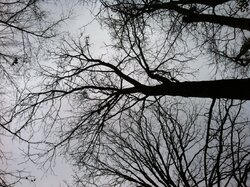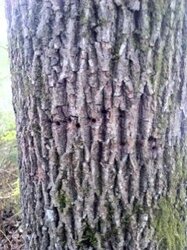Last edited:
help identifying tree
- Thread starter Rebelduckman
- Start date
-
Active since 1995, Hearth.com is THE place on the internet for free information and advice about wood stoves, pellet stoves and other energy saving equipment.
We strive to provide opinions, articles, discussions and history related to Hearth Products and in a more general sense, energy issues.
We promote the EFFICIENT, RESPONSIBLE, CLEAN and SAFE use of all fuels, whether renewable or fossil.
You are using an out of date browser. It may not display this or other websites correctly.
You should upgrade or use an alternative browser.
You should upgrade or use an alternative browser.
- Status
- Not open for further replies.
Applesister
Minister of Fire
Whats Ms? Minnesota?
Ash maybe...its hard for me to ID White Ash because I see Green Ash here. Green has very uniform fine fissures and ridges that form fine diamond patterns.
White is rougher but this tree seems to have a much larger pattern. But still fairly uniform. Elm is very similar but more uneven. the fissures wrap around limbs and change as the tree broadens. Ash is very uniform down the length of the trunk. Ash bark is much lighter than Elm.
In Minnesota it could be another species altogether. And that was really helpful...all that.
Im saying Ash for $10.00
Ash maybe...its hard for me to ID White Ash because I see Green Ash here. Green has very uniform fine fissures and ridges that form fine diamond patterns.
White is rougher but this tree seems to have a much larger pattern. But still fairly uniform. Elm is very similar but more uneven. the fissures wrap around limbs and change as the tree broadens. Ash is very uniform down the length of the trunk. Ash bark is much lighter than Elm.
In Minnesota it could be another species altogether. And that was really helpful...all that.
Im saying Ash for $10.00
Applesister
Minister of Fire
Yellow bellied sap suckers love Elm and Hickory...lol. Its amazing they can even get thru the bark.
Whats Ms? Minnesota?
Ash maybe...its hard for me to ID White Ash because I see Green Ash here. Green has very uniform fine fissures and ridges that form fine diamond patterns.
White is rougher but this tree seems to have a much larger pattern. But still fairly uniform. Elm is very similar but more uneven. the fissures wrap around limbs and change as the tree broadens. Ash is very uniform down the length of the trunk. Ash bark is much lighter than Elm.
In Minnesota it could be another species altogether. And that was really helpful...all that.
Im saying Ash for $10.00
Central Mississippi
Could be any of the above. Too little information. Would guess elm or hickory. Need a split or shot of entire tree.
I'll get a shot of the tree tomorrow and post.
If you can get a picture of a twig it would be very helpful
Coming later today thanks
blazincajun
Burning Hunk
Twigs and leaf scars; also, look for the presence of hickory nut husks in the leaf and duff layer around the tree. Identify the topographic position on the landscape as well.
nrford
Minister of Fire
Twigs and leaf scars; also, look for the presence of hickory nut husks in the leaf and duff layer around the tree. Identify the topographic position on the landscape as well.
Gee wiz How about a birth cert. and SS#......

Applesister
Minister of Fire
Elm doesnt have nuts. The crown is not Elm and the branches dont look opposite(ash).
The leaf scars on hickories look like monkey faces.
find some nut husks and take pics.
If this is the same tree from your other IDs I said Mockernut just because the bark in your photo seemed just a hair too dark for Ash.
The bark is very rough and very hard on hickory.
The leaf scars on hickories look like monkey faces.
find some nut husks and take pics.
If this is the same tree from your other IDs I said Mockernut just because the bark in your photo seemed just a hair too dark for Ash.
The bark is very rough and very hard on hickory.
G
e="blazincajun, post: 1690704, member: 31981"]Twigs and leaf scars; also, look for the presence of hickory nut husks in the leaf and duff layer around the tree. Identify the topographic position on the landscape as well.[/quote]
Gotts
Will do. The bark on this is hard and rough just like you say. Most likely hickory then huh?
e="blazincajun, post: 1690704, member: 31981"]Twigs and leaf scars; also, look for the presence of hickory nut husks in the leaf and duff layer around the tree. Identify the topographic position on the landscape as well.[/quote]
Gotts
Elm doesnt have nuts. The crown is not Elm and the branches dont look opposite(ash).
The leaf scars on hickories look like monkey faces.
find some nut husks and take pics.
If this is the same tree from your other IDs I said Mockernut just because the bark in your photo seemed just a hair too dark for Ash.
The bark is very rough and very hard on hickory.
Will do. The bark on this is hard and rough just like you say. Most likely hickory then huh?
blazincajun
Burning Hunk
Twigs on hickories are usually thicker than elm twigs. Looks hickory to me.
All our opinions really are based on our own experience in the forest or dealing with local trees that are obviously accurately identified or other experiences. So the members here usually give an opinion based on the photos and short of being there we usually give our best opinion. Also, the same species will have minor physical differences (i.e., color, growth, height, bark texture, branching) based on site location - taxonomy uses a decision tree (keys). If you are really interested in learning your trees, see if you can get a taxonomy book, find the species you think the tree is and work backwards. As you encounter terms that you are unfamiliar with, these books usually have a glossary that will help you through the keys. This will usually ring some bells and help with your identification. Sometimes it only takes a simple description to confirm your tree. Local libraries usually have books on common trees in your state. Have fun.
All our opinions really are based on our own experience in the forest or dealing with local trees that are obviously accurately identified or other experiences. So the members here usually give an opinion based on the photos and short of being there we usually give our best opinion. Also, the same species will have minor physical differences (i.e., color, growth, height, bark texture, branching) based on site location - taxonomy uses a decision tree (keys). If you are really interested in learning your trees, see if you can get a taxonomy book, find the species you think the tree is and work backwards. As you encounter terms that you are unfamiliar with, these books usually have a glossary that will help you through the keys. This will usually ring some bells and help with your identification. Sometimes it only takes a simple description to confirm your tree. Local libraries usually have books on common trees in your state. Have fun.
blazincajun
Burning Hunk
When you say opposite branches you mean the branches on the limb don't line up with each other?
Opposite twigs become opposite branches sometimes versus alternate branching. Look at any stem and if the leaves (not leaflets) are on opposite sides of the twig this is known as opposite branching. Otherwise, trees with leaves that alternate around a stem are known as alternate branching like hickory and elm. Opposites include dogwood, ash, viburnum, maple, buckeye, strawberry bush and privets.
Applesister
Minister of Fire
I have Norway maples, Green Ash and Shagbark hickories in my back yard. I pass them every day on my way to the horsebarn.
I would take pictures for you to help with this but we are in the midst of another ice storm.
If you saw pictures you would think Oh..YEAH
Opposite twig growth on a limb mirrors or balances another. Usually always in pairs.
Alternate twig growth staggers along the limb, and is more random.
I would take pictures for you to help with this but we are in the midst of another ice storm.
If you saw pictures you would think Oh..YEAH

Opposite twig growth on a limb mirrors or balances another. Usually always in pairs.
Alternate twig growth staggers along the limb, and is more random.
That should
that should help out alot thanks
I have Norway maples, Green Ash and Shagbark hickories in my back yard. I pass them every day on my way to the horsebarn.
I would take pictures for you to help with this but we are in the midst of another ice storm.
If you saw pictures you would think Oh..YEAH
Opposite twig growth on a limb mirrors or balances another. Usually always in pairs.
Alternate twig growth staggers along the limb, and is more random.
that should help out alot thanks
- Status
- Not open for further replies.
Similar threads
- Replies
- 46
- Views
- 2K



